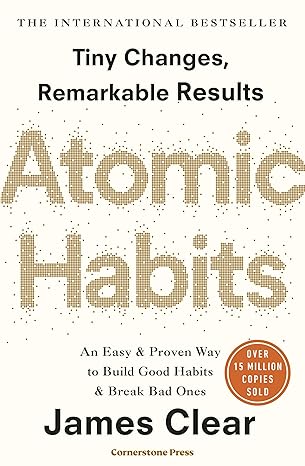"This is why you can’t get too attached to one version of your identity. Progress requires unlearning ..." - James Clear
I found Atomic Habits much later than most of the other books I've recommended. I first spotted it when I saw someone reading it on a train. The bombastic title caught my eye, and I was curious to find out more. Even though it was published around ten years after many of the others on my recommendations list, it fits surprisingly well alongside them. It tessellates with their ideas in a really satisfying way. The themes of logic, patterns and behavioural economics are present in this book, but just applied to a smaller more individual scale. I liked that this book shows that human nature is shaped by repetition, priming, and a kind of gentle mental training. Almost like how you might train a dog. In lots of ways, it helped clarify how I think the brain works. Positive reinforcement, consistent repetition, and a clear structure all feel essential for changing behaviour.
Synopsis
Atomic Habits: An Easy & Proven Way to Build Good Habits & Break Bad Ones by James Clear. was published in 2018, it has sold millions of copies and has been a New York Times bestseller for an extended period.
The core premise of the book is that small, incremental changes to your habits can lead to significant and transformative results over time. Clear argues that it’s not about huge, overnight transformations, but rather about the “compound interest” of consistently making 1% improvements each day.
Here are the key takeaways and concepts from “Atomic Habits”:
Focus on Systems, Not Goals: While goals provide direction, Clear emphasizes that true progress comes from building effective systems. You don’t rise to the level of your goals; you fall to the level of your systems. This means creating daily routines and processes that make desired behaviors inevitable and undesired ones difficult.
Identity-Based Habits: Instead of focusing on what you want to achieve (outcomes), Clear suggests focusing on who you want to become (identity). For example, instead of setting a goal to run a marathon, aim to become “a runner.” Every action you take is a “vote” for the type of person you wish to be. When your habits align with your desired identity, they become much more sustainable.
The Four Laws of Behavior Change: Clear provides a practical framework for building good habits and breaking bad ones, based on these four laws:
Make it Obvious (Cue): Design your environment to make the cues for good habits visible and accessible, and the cues for bad habits invisible.
Make it Attractive (Craving): Make your desired habits more appealing. This can involve “temptation bundling” (pairing a desired activity with a necessary one) or associating positive feelings with the habit.
Make it Easy (Response): Reduce the friction associated with good habits. The “Two-Minute Rule” suggests starting a new habit by doing it for just two minutes to get started. Conversely, make bad habits difficult to perform.
Make it Satisfying (Reward): Ensure that there is an immediate and satisfying reward for performing the good habit. This reinforces the behavior and makes you more likely to repeat it.
The Power of Small Habits: Even seemingly insignificant changes, when repeated consistently, can lead to remarkable long-term outcomes. The idea is to get 1% better every day.
Habit Stacking: A technique where you link a new habit to an existing one. For example, “After I brew my coffee each morning, I will meditate for one minute.”
Environment Design: Your environment plays a crucial role in shaping your habits. By consciously designing your surroundings, you can make good habits easier and bad habits harder.
Never Miss Twice: This rule acknowledges that perfection isn’t possible, but emphasizes the importance of getting back on track quickly after a slip-up. Missing once is an accident; missing twice is the start of a new, undesirable habit.
In essence, “Atomic Habits” provides a clear, actionable, and evidence-based guide to understanding how habits work and how to leverage that knowledge to create positive, lasting change in any area of your life.
Key Points
- Tiny changes build up
- Focus on identity; who you want to be
- Be aware of how your environment encourages habits
- Track progress, be patient
- Remove barriers, make good habits easy

